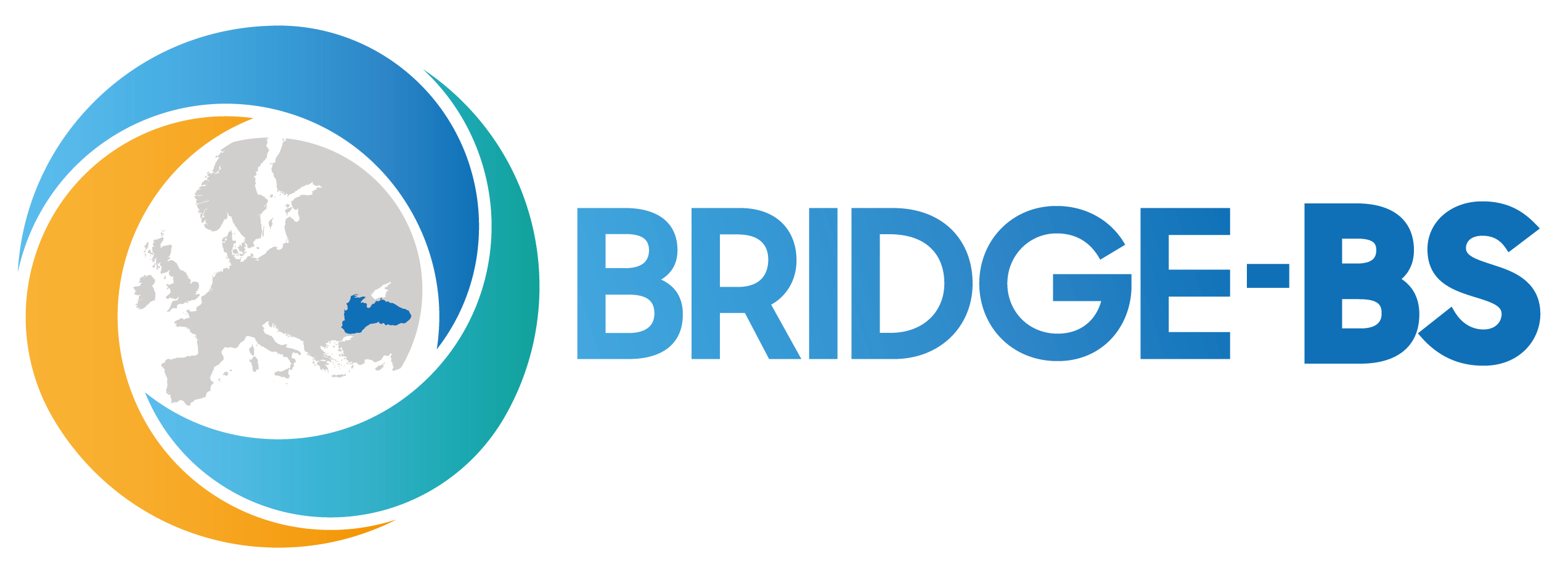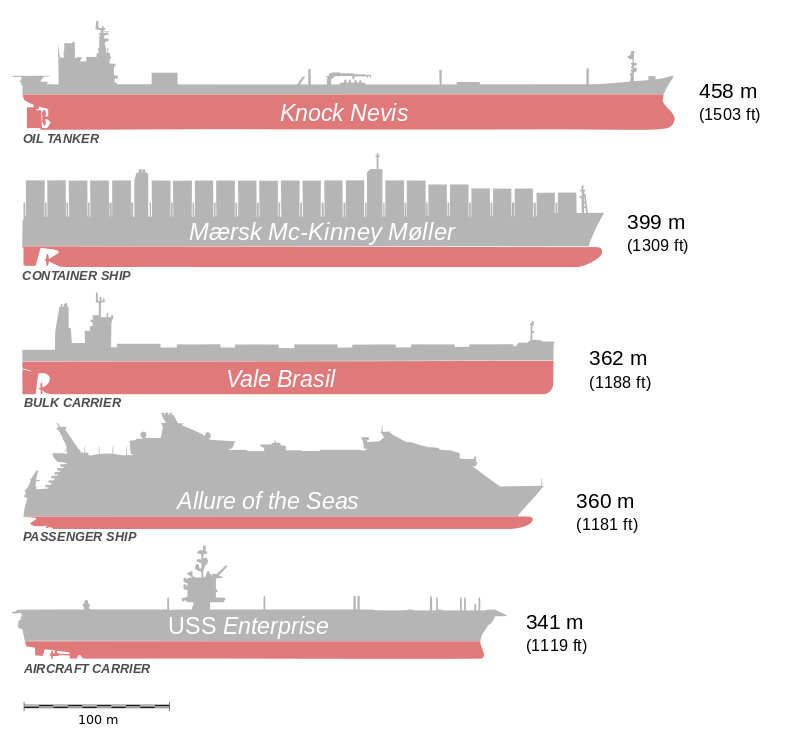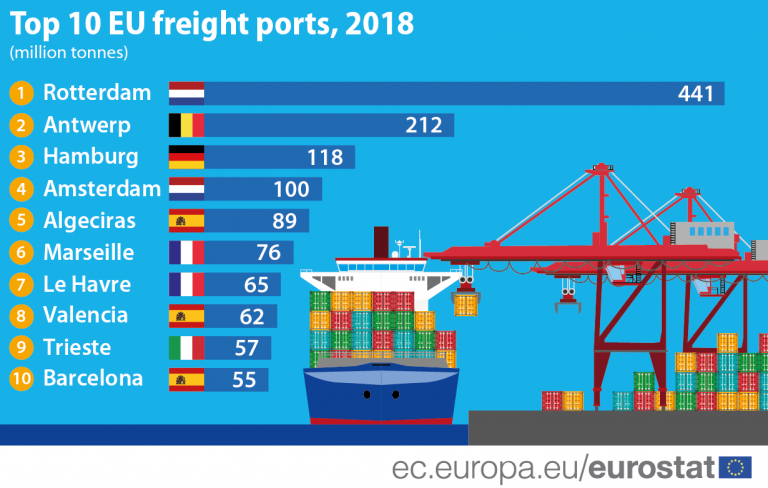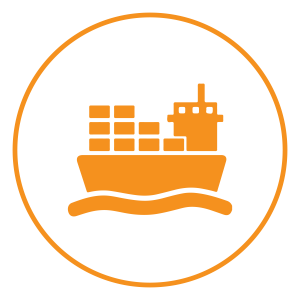
MARITIME TRANSPORT
The EU Blue Economy consists of established (i.e. those that traditionally contribute to the Blue Economy) and emerging and innovative sectors. The Virtual Blue Career Center (VBCC) presents three selected sectors; (1) Shipbuilding and Repair, (2) Port Activities, and (3) Maritime Transport. They are collectively referred to as Maritime transport. There are also corresponding subsectors of emerging ones, which are as follows:
(1) Shipbuilding and repair – Shipbuilding, Equipment, and Machinery
(2) Port activities - Cargo and Warehousing, Port and Water Projects
(3) Maritime Transport - Passenger Transport, Freight transport, Services for Transport

SHIPPING
Shipping is the most carbon-efficient mode of transportation. International maritime shipping accounts for less than 3% of annual global greenhouse gas emissions (CO2) and produces less exhaust gas emissions – including nitrogen oxides (NOx), hydrocarbons, carbon monoxide (CO), and sulfur dioxide (SO2) – for each tonne transported per kilometer than air or road transport.
Shipbuilding and Repair
The EU shipbuilding industry is a dynamic and competitive sector. With a market share of around 6% of the global order book in terms of compensated gross tonnage176 and 19% in terms of value; for marine equipment, the EU share rises to 50%; the EU is a major player in the global shipbuilding industry.
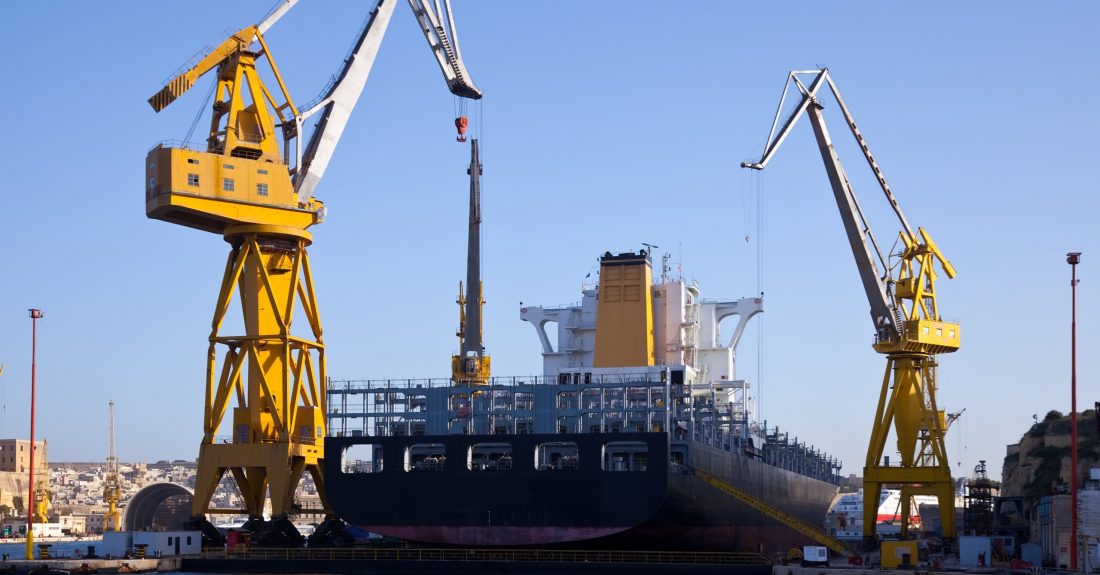
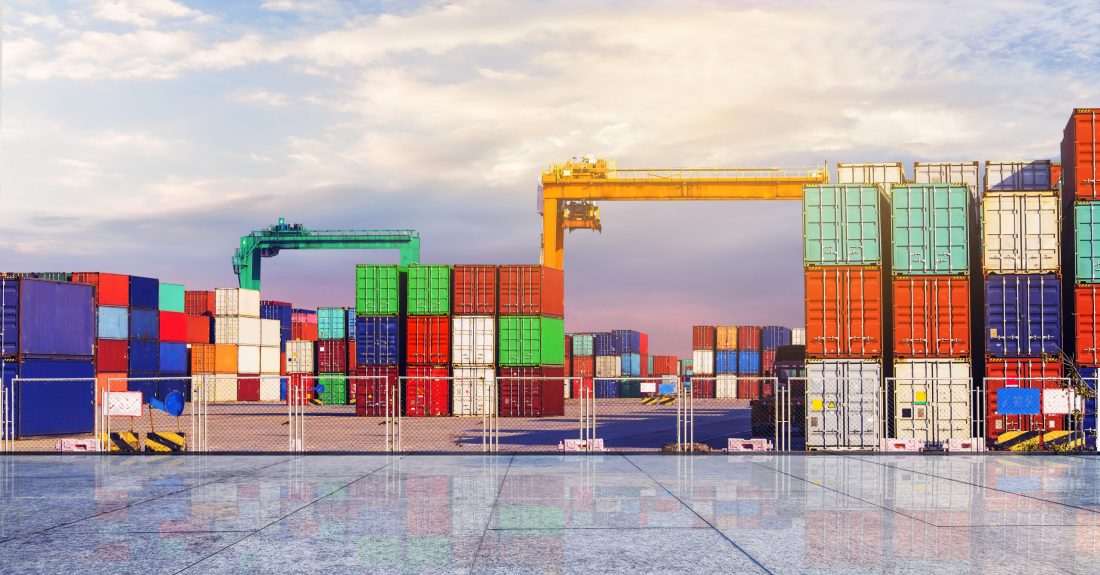
PORTS
Port activities continue to play a key role in trade, economic development, and job creation. The number of containers heading into European ports has risen by more than four times over the past 20 years161. Europe’s busiest container ports include Rotterdam (the Netherlands), Antwerp (Belgium); Hamburg (Germany); Amsterdam (the Netherlands), and Algeciras (Spain).
MEDIA CORNER
NEWS
THE MARITIME EXECUTIVE
SEATRADE MARITIME NEWS
TRADEWINDS
EXPLORE THE OPPORTUNITIES
Occupation | Description |
Ship Captain | Ship captains are in charge of a vessel for the transportation of goods and passengers, operating in offshore and coastal waters. The size of the vessel can range from a small vessel to a cruise liner depending on the tonnage that they are certified to sail. Ship captains have vast experience with ships and their operation and are likely to have worked their way through the ranks of other ship-related positions. |
Deck officer | Deck officers or mates perform the watch duties on board of vessels like determining the course and speed, manoeuvring to avoid hazards, and continuously monitoring the vessels position using charts and navigational aids. They maintain logs and other records tracking the ship's movements. They ensure that the proper procedures and safety practices are followed, check that equipment is in good working order, and oversee the loading and discharging of cargo or passengers. They supervise crew members engaged in maintenance and the primary upkeep of the vessel. |
Crew Manager | The Crew Manager acts as the senior manager of all crew, handling all aspects of Crew Management and many HR tasks. He ensures that the crew deliver the best possible service, coordinating any training or promotions. All aspects of Crew Management fall under his responsibility, including the handling of personnel related budgets and travel budgets. The Crew Manager must assess the suitability of the staff employed, ensuring they are within the legal guidelines of the vessel for rank, qualifications and medical certificates. |
Marine chief engineer | Marine chief engineers are responsible for the entire technical operations of the vessel including engineering, electrical, and mechanical divisions. They are the head of the entire engine department aboard the ship and have overall responsibility for all technical operations and equipment on-board the ship. Marine chief engineers collaborate on security, survival and health care on board and observe the national and international standards of application. |
Marine electrician | Marine electricians install, maintain and repair electrical and electronic systems in vessels such as air conditioning systems, lamps, radios, heating systems, batteries, electrical wiring, and alternators. They use diagnostic testing equipment to inspect vessels and find faults. To do repair work, they use hand tools and specialised electrical instruments and machines. |
Ship Broker | Shipbrokers act as intermediaries between buyers and sellers of ships, cargo space on ships and charter ships for the transfer of cargo. They inform clients on the shipping market mechanisms and movements, report on vessel and cargo space prices and sales, and negotiate not only the cost of the vessels, cargo space or cargo but also the logistical requirements for the transfer of the vessel or commodity cargo to the buyers. |
Ship Manager | Ship Managers do not generally own ships; instead they agree a contract with Ship Owners to efficiently operate, manage and maintain their fleet. The activities could range from simply providing a crew for the ship to full management, including commercial operations, organizing insurance, purchasing stores, technical maintenance, as well as crewing the ships. Ship Managers provide Ship Owners with regular financial and technical reports on the ships under management.. |
Shipping agent | Shipping agents represent the ship owner in a foreign port. They make sure customs is cleared in a timely manner so that the cargo doesn't have to stay too long in the port. Shipping agents also ensure that insurance, licences and other formalities are in order. |
Marine surveyor | Marine surveyors inspect vessels intended for operations in maritime or open sea waters. They ensure that vessels and equipment follow the regulations laid down by the International Maritime Organisation (IMO). They may also act as third parties for the review of offshore facilities and construction projects. Within shipbuilding and ship repair projects they play a pivotal role in the entire process of ship construction. The survey is performed by a classification society to certify the design and construction of the ship. The classification society, in turn, appoints a team of surveyors who are posted in the shipyard and are responsible for certifying every stage of construction including every weld joint. One of the most important advantages of this career is an exposure to the latest marine construction technologies. Engineers (mechanical, electrical, civil) and naval architects are recruited as marine surveyors by classification societies. |
Marine cargo inspector | Marine cargo inspectors investigate all baggage and freight listed on the ship's manifest. They are responsible for checking the condition of the cargo and verifying the cargo's documentation and compliance with rules and regulations. Marine cargo inspectors analyse the vessels' capabilities, the fuel compartments, the safety equipment and the specific licenses required. |
Freight Forwarder | Freight Forwarders act as intermediaries between importers and exporters, seek out and then coordinate the most cost effective and fitting way to move goods between nations. This job requires excellent contacts in all the transport modes and a sound understanding of rules and regulations relating to the carriage of goods. Excellent relations with shipping companies and other transport modes allow them to find and negotiate the best transport arrangements for clients, although in some cases, the freight forwarding company itself provides the service. Usually they select safe routes and carriers; negotiate contracts, transportation and handling costs; book cargo space; arrange appropriate packing; deal with transport rates, insurance and schedules; make calculations by weight, volume and cost; prepare quotations and invoices; and prepare contracts. |
Marine Underwriter | One of the oldest activities related to the shipping, traditionally encompasses the insurance of ships or their cargo against specified causes of loss or damage that might be encountered at sea. Marine Insurance now also covers the transit of cargo over land at each end of the voyage. The term ‘vessel’ has now also been extended to include ships under construction or repair and drilling rigs. Marine Underwriters cover four main strands of loss and damage of ship cargoes, terminals, ships and their property, namely Marine Hull Insurance, Marine Liability Insurance, Marine Cargo Insurance, and Offshore/Energy. |
Port coordinator | Port coordinators manage operations of traffic division for port authorities. They enforce rules and regulations, such as the berthing of ships, handling and storing of cargo, and the use of port facilities. They direct policing and cleaning activities of the harbour department land, streets, buildings, and water areas. Port coordinators also ensure that activities concerning revenue are documented and submitted to the accounting division. They advise port authorities on rates and revisions of port tariff, and solicit steamship companies to use port facilities. They direct activities concerned with compiling daily and annual ship and cargo statistics. |
Port Operations Manager/Port Terminal Manager | The Port Operations Manager is responsible for the smooth transition of the cargo, so that it reaches its destination on time, as well as for planning, administration and review of the operations, in order to optimize resource use, minimize costs and maintain quality standards. To perform this role, the Port Operations Manager will need to be in close contact with a range of industry groups, such as customs and quarantine, stevedores and shipping lines. |
Stevedore superintendent | Stevedore superintendents supervise and monitor the freight handling and longshore labor in a dockyard to maximise productivity. They manage the loading and unloading of cargo and monitor the safety of the work area. Stevedore superintendents may also investigate incidents and prepare accident reports. |
Maritime Pilot | The duties of maritime pilots are quite different from that of the ship’s captain. The marine/ship pilot acts as the person who advises the captain what route to take and what changes need to be made during ship’s routine manoeuvring while entering or leaving a port. The pilot being local ensures that he is familiar with the water area and thereby is able to guide the ship appropriately. |
Vessel Traffic Operator | A Vessel Traffic Controller/Operator is responsible for the coordination of ships within the port or harbour area so that to avoid collisions or incidents by managing movements from a port control centre. They may also offer traffic information and arrange for launches to take Pilots out to ships. To perform this job, Vessel Traffic Controllers/Operators are well versed in the use of computerized Vessel Traffic Management systems. will generally operate radar and radio equipment, make use of nautical charts to record a ship’s current position, plot courses, and forecast traffic flows. |
Purchasing Manager | Purchasing managers oversee buying goods, equipment, and services for their company, and try to ensure the most competitive prices. They are also responsible for negotiating contracts, reviewing the quality of products, and analysing suppliers, and for the use and resale of goods and services |
Naval architect | Naval architects design, build, maintain and repair all types of boats from pleasure crafts to naval vessels, including submarines. They analyse floating structures and take various features into account for their designs such as the form, structure, stability, resistance, access and propulsion of hulls. |
Ship planner | Ship planners manage the performance of a vessel. They ensure the safety of the vessel and its cargo, its operationality and link available vessels to available cargos in order to maximise the profitability of the voyages. They ensure that each container ship is loaded to its optimal capacity, while keeping berth times and handling costs to a minimum. They also plan the maintenance and overhaul of the ship, as well as the crew needed. |
Marine engineer | Marine engineers design, build, maintain and repair the hull, mechanical, electronic equipment and auxiliary systems such as engines, pumps, heating, ventilation, generator sets. They work on all types of boats from pleasure crafts to naval vessels, including submarines. |
Quality Control Inspector | QC Inspectors are one of the most skilled people among the workforce in a shipyard, and such roles are usually given to ones with sufficient experience in shipbuilding. They are responsible for carrying out non-destructive tests on weld joints, and carry out dimensional control inspections of every major structure after its installation. The design drawings are used as a reference for checks on dimensions, which makes it necessary for them to be well adept in reading of complex production drawings. |
No | Institution | Type of Organization | Type of Education | Legal Status | City | Country | Web page |
1. | Nikola Vaptsarov Naval Academy | University | Higher Education | Public | Varna | Bulgaria | http://www.naval-acad.bg |
2. | Technical University of Varna | University | Higher Education | Public | Varna | Bulgaria | https://www1.tu-varna.bg |
"Angel Kanchev" University of Ruse | University | Higher Education | Public | Ruse | Bulgaria | https://www.uni-ruse.bg | |
3. | University of Architecture, Civil Engineering and Geodesy | University | Higher Education | Public | Sofia | Bulgaria | http://uacg.bg |
4. | Bulgarian Ship Hydrodynamics Centre | National Research and Development Center | Other | Public | Varna | Bulgaria | http://www.bshc.bg |
5. | Institute of Oceanology | Research Organization | Other | Public | Varna | Bulgaria | http://io-bas.bg |
6. | Batumi Navigation Teaching University | University | Higher Education | private | Batumi | Georgia | https://bntu.edu.ge |
7. | Batumi State Maritime Academy | University | Higher Education | Public | Batumi | Georgia | https://bsma.edu.ge |
8. | Batumi Shota Rustaveli State University | University | Higher Education | Public | Batumi | Georgia | https://bsu.edu.ge |
9. | Constanta Maritime University | University | Higher Education | Public | Constanta | Romania | https://cmu-edu.eu |
10. | Dunarea De Jos University | University | Higher Education | Public | Galati | Romania | http://www.naoe.ugal.ro |
11. | Governmental Yıldız Technical University | University | Higher Education | public | Istanbul | Turkey | https://yildiz.edu.tr |
12. | Middle East Technical University – Institute of Marine Sciences | University | Higher Education | public | Ankara | Turkey | https://www.metu.edu.tr |
13. | Istanbul University | University | Higher Education | public | Istanbul | Turkey | https://www.istanbul.edu.tr |
14. | Karadeniz Technical University, Institute of Natural and Applied Sciences | University | Higher Education | public | Trabzon | Turkey | https://www.ktu.edu.tr |
15. | Recep Tayyip Erdoğan University, Institute of Graduate Studies | University | Higher Education | public | Rize | Turkey | https://erdogan.edu.tr |
16. | Piri Reis University | University | Higher Education | private | Istanbul | Turkey | https://www.pirireis.edu.tr |
17. | Zirve University | University | Higher Education | Private | Gaziantep | Turkey | www.zirve.edu.tr |
18. | Dokuz Eylül University | University | Higher Education | Private | Izmir | Turkey | https://www.deu.edu.tr |
19. | Mustafa Kemal University | University | Higher education | Public | Hatay | Turkey | https://www.mku.edu.tr |
20. | Odessa National Maritime University | University | Higher education | Public | Odessa | Ukraine | www.onmu.odessa.ua |
21. | Admiral Makarov National University of Shipbuilding | University | Higher education | Public | Mykolaiv | Ukraine | https://nuos.edu.ua |
